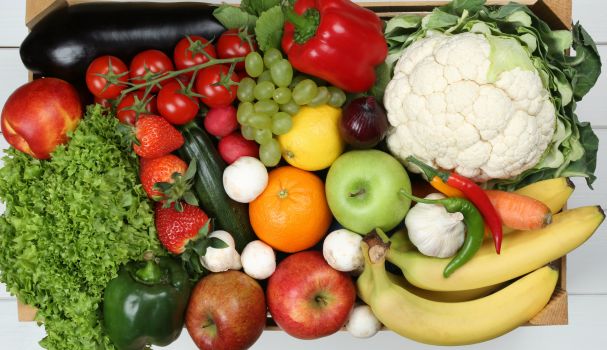Best New Year’s Diet Starts With Easy Kitchen Detox

Forget trendy cleanses; eating healthy is the best way to promote health. Credit: Copyright Dreamstime.com
Still looking for the perfect cleanse to start the year off right? Look no further.
Whether you’re following the brouhaha surrounding the 2015-2020 Dietary Guidelines for Americans or not, I’m betting you already know what the basics of a healthy diet (still) are: mounds of vegetables and fruits, whole grains, and lean and sustainable proteins like beans, nuts and legumes. Healthy oils like olive, grapeseed, walnut and flax also play a role. If these foods are the stars of your plate, your year is off to a terrific start.
So what of the other things we chomp, such as cookies, chips, ice cream, candy, chocolate, soda and the like? And if you did overindulge during the holidays, what’s the remedy for restoring your health, and perhaps even losing a few pounds?
Exactly right. You need a cleanse.
Not that type of cleanse
No, I’m not talking about the kind of cleanse touted by too-skinny celebrities and junk-science food bloggers. There’s no evidence behind the vast majority of regimens floating around cyberspace. And guess what? Homo sapiens is a wondrous machine equipped with “detox” organs like the liver, kidneys and the gastrointestinal system, which work to clear your body of noxious substances you don’t need — including those found in food. That’s not to say that treating your body like a dump is a good idea; it’s not, and there’s no reason to make it work extra hard by feeding it junk. But human metabolism is magnificent at removing toxins from the body, while a short-term diet or cleanse offers little in the long run to sustain weight loss and promote health; some may even be harmful.
The cleanse I’m referring to doesn’t have a catchy name (sorry) and doesn’t require a blender (thankfully). And it’s not some weird juice with strange ingredients and a funky flavor (happily). Most important, there are plenty of studies to support that this type of cleanse will, if done correctly, improve your health and weight.
Now take a look around your kitchen pantry, counter, refrigerator and freezer. What do you see? If you’re staring at gallons of ice cream, boxes of cookies, bags of chips and cans of soda (not to mention sweetened yogurts and granola bars), the thing that would most benefit from a “cleanse” is not your body, but your abode. And, unlike your human form, your habitat needs you to do the cleaning. Simply speaking, no matter your dietary vices — and you know what makes you drool — they don’t belong in your house.
Behavioral research studies examining eating behavior (like this one, for example) show that you shouldn’t keep temptations close at hand, since that means — Duh! — you’re more likely to gobble them up. Science aside, common sense and adages like “out of sight, out of mind” tell you exactly the same thing.
Treats are often consumed in too-large portions that contribute substantial calories and few nutrients. They also tend to be loaded in sugar and refined carbohydrates (like white flour), and most of us eat more than is good for our health. Indeed, consuming foods with lots of added sugar (not the kinds found naturally in fruits) are related to a greater risk of heart disease and type 2 diabetes; the risk remains, even if you’re at a healthy body weight. That’s why the new Dietary Guidelines state that everyone should limit added sugars to no more than 10 percent of daily intake.
Enjoy, in moderation
Make no mistake: I love indulgences like gooey brownies and crunchy potato chips just as much as the next girl. I developed a keen sweet tooth growing up and it took many years to tame. The key was learning to keep goodies special, as if a guest were visiting, and never give them a permanent place on my grocery list or on my kitchen counter. Certainly more logical (and less painful) than rigging the cookie jar with a mousetrap.
I still think about savoring something sweet after everyday dinners, like many of us. But guess what? If there’s nothing around, I get over it. Or I suck it up: you simply cannot eat what’s not there. Excess-calories-I-don’t-need and overeating episode averted. Following most suppers today, I enjoy cut-up fruit or berries, and occasionally a small piece of chocolate. (And I save the outrageous desserts that I adore for special occasions only.)
Once every few months or so I’ll take a trip to my local gelateria or pick up a pint of ice cream that my husband and I share over a couple of days’ time. If I’m craving salty snacks, I’ll buy a single serving bag or split a small sack with my husband. Do remember: ridding your house of temptation doesn’t imply you’ll never eat these scrumptious things, it simply means they aren’t commonly found in your freezer. Over time, you’ll find you have less of an appetite for sugar and salt as your taste buds adapt.
You can’t control many things in your environment, whether the workplace cafeteria, shopping mall food court or supermarket aisles. But you can control what you have in your house — as well as your car and your office. The spaces where you spend the most time should be filled with food that nourishes your body, not packed with nutritional landmines ready to explode at every turn. To clean up your diet, clean out your house.
It’s the only “cleanse” you need.
[“source-ndtv”]
